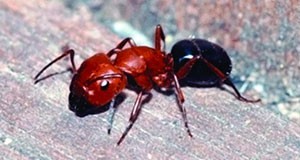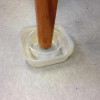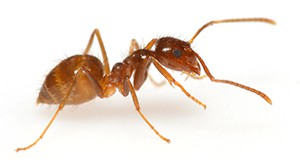As of 2012, tawny crazy ants have invaded 24 counties in Florida, parts of southeast Texas, and other areas of the southeastern U.S. The tawny crazy ant is considered a series pest. This species infests buildings and greenhouses, attacks crops, domestic animals, honeybee hives, displaces native ant species, and disrupts electrical equipment. This 3-page fact sheet covers the tawny crazy ant’s distribution, description, colonies, feeding habits, and pest status and control. Written by S. K. Hill, R. W. Baldwin, R. M. Pereira, and P. G. Koehler, and published by the UF Department of Entomology and Nematology, October 2013.
http://edis.ifas.ufl.edu/in1076
Tag: Roberto M. Pereira
Florida Carpenter Ants
 Carpenter ants are in the genus Camponotus, in which up to over 900 species have been described worldwide. They get their common name, “carpenter ant,” because some species excavate nests in wood. Carpenter ants are sometimes called bulldog ants or bull ants. However, not all species in the genus Camponotus are true carpenter ants because some nest in preformed cavities or in soil. This 5-page fact sheet was original published as part of Pests in and around the Florida Home, and was written by R. J. Vazquez, P. G. Koehler, R. M. Pereira, J. Warner, and R. H. Scheffrahn, and published by the UF Department of Entomology and Nematology, October 2013.
Carpenter ants are in the genus Camponotus, in which up to over 900 species have been described worldwide. They get their common name, “carpenter ant,” because some species excavate nests in wood. Carpenter ants are sometimes called bulldog ants or bull ants. However, not all species in the genus Camponotus are true carpenter ants because some nest in preformed cavities or in soil. This 5-page fact sheet was original published as part of Pests in and around the Florida Home, and was written by R. J. Vazquez, P. G. Koehler, R. M. Pereira, J. Warner, and R. H. Scheffrahn, and published by the UF Department of Entomology and Nematology, October 2013.
http://edis.ifas.ufl.edu/in1075
Como hacer una trampa interceptora de chinches de cama de articulos comunes del hogar.
 Las chinches de cama se han convertido en un problema de plagas cada vez más común en los Estados Unidos. Se han encontrado en muchos lugares diferentes en donde vive la gente, desde escuelas y restaurantes a consultorios médicos y salas de cine, pero las peores infestaciones son por lo general en lugares donde vive la gente, descansan y duermen como en casas, pisos, apartamentos, hoteles y refugios para desamparados. Las chinches de cama son más comunes en lugares como alrededor de piezas de mobiliario en donde la gente se sienta o acuesta- camas, sillas y sofás. Para descubrir si las chiches están presentes en una habitación o un mueble, el dispositivo llamado trampa interceptora de chinches puede ser útil. Las trampas interceptoras atrapan y recogen las chinches de cama cuando tratan de viajar entre sus huéspedes humanos y sus escondites. Las trampas interceptoras de chinches de cama son fácilmente hechas de artículos del hogar y recipientes de plástico desechables. This 4-page fact sheet was written by Benjamin A. Hottel, Rebecca W. Baldwin, Roberto M. Pereira, and Philip G. Koehler, and published by the UF Department of Entomology and Nematology, February 2014.
Las chinches de cama se han convertido en un problema de plagas cada vez más común en los Estados Unidos. Se han encontrado en muchos lugares diferentes en donde vive la gente, desde escuelas y restaurantes a consultorios médicos y salas de cine, pero las peores infestaciones son por lo general en lugares donde vive la gente, descansan y duermen como en casas, pisos, apartamentos, hoteles y refugios para desamparados. Las chinches de cama son más comunes en lugares como alrededor de piezas de mobiliario en donde la gente se sienta o acuesta- camas, sillas y sofás. Para descubrir si las chiches están presentes en una habitación o un mueble, el dispositivo llamado trampa interceptora de chinches puede ser útil. Las trampas interceptoras atrapan y recogen las chinches de cama cuando tratan de viajar entre sus huéspedes humanos y sus escondites. Las trampas interceptoras de chinches de cama son fácilmente hechas de artículos del hogar y recipientes de plástico desechables. This 4-page fact sheet was written by Benjamin A. Hottel, Rebecca W. Baldwin, Roberto M. Pereira, and Philip G. Koehler, and published by the UF Department of Entomology and Nematology, February 2014.
http://edis.ifas.ufl.edu/in1026
How to Make a Bed Bug Interceptor Trap out of Common Household Items
 Bed bugs have become an increasingly common pest problem throughout the United States. To discover whether bed bugs are present in a room or a piece of furniture, you can make interceptor traps out of commonly found household items and disposable plastic containers. This 5-page fact sheet was written by Benjamin A. Hottel, Rebecca W. Baldwin, Roberto M. Pereira, and Philip G. Koehler, and published by the UF Department of Entomology and Nematology, January 2014.
Bed bugs have become an increasingly common pest problem throughout the United States. To discover whether bed bugs are present in a room or a piece of furniture, you can make interceptor traps out of commonly found household items and disposable plastic containers. This 5-page fact sheet was written by Benjamin A. Hottel, Rebecca W. Baldwin, Roberto M. Pereira, and Philip G. Koehler, and published by the UF Department of Entomology and Nematology, January 2014.
http://edis.ifas.ufl.edu/in1022
¿Qué te está picando? (ENY2015S/IN927)
 Pulgas, piojos, chinches, o garrapatas? Ponle atención a tu insecto para que sepas lo que es. This poster was written by E. E. Harlow, C. A. McNeill, R. W. Baldwin, R. M. Pereira, P. G. Koehler, and J. C. Medley, and published by the UF Department of Entomology and Nematology, April 2012.
Pulgas, piojos, chinches, o garrapatas? Ponle atención a tu insecto para que sepas lo que es. This poster was written by E. E. Harlow, C. A. McNeill, R. W. Baldwin, R. M. Pereira, P. G. Koehler, and J. C. Medley, and published by the UF Department of Entomology and Nematology, April 2012.
http://edis.ifas.ufl.edu/in927
What Is Biting You? (ENY2015/IN926)
 Why are you itchy? Identify the problem pest with this handy poster written by E. E. Harlow, C. A. McNeill, R. W. Baldwin, R. M. Pereira, P. G. Koehler, and J. C. Medley, and published by the UF Department of Entomology and Nematology, April 2012.
Why are you itchy? Identify the problem pest with this handy poster written by E. E. Harlow, C. A. McNeill, R. W. Baldwin, R. M. Pereira, P. G. Koehler, and J. C. Medley, and published by the UF Department of Entomology and Nematology, April 2012.
http://edis.ifas.ufl.edu/in926
